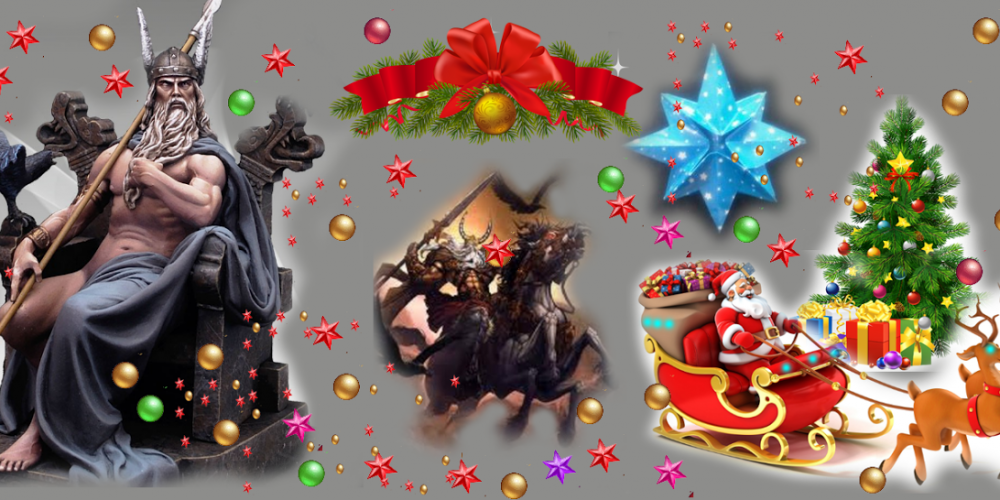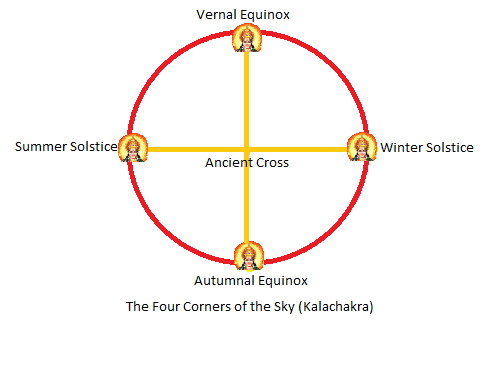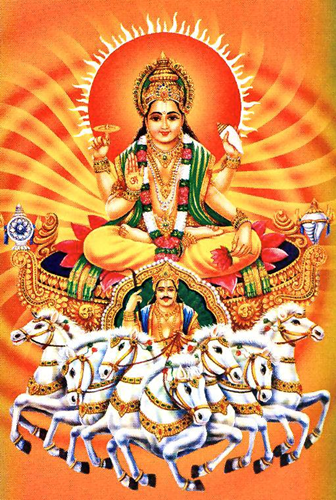December 21st is the Winter Solstice, when we have the shortest day and the longest night. It is the day of great significance to the ancient traditions of the world, in ancient Bharata and in the rest of the world. Ancient sky watchers (whose ancient tradition of sky watching later gave rise to astronomy and astrology much popular in the modern world) constantly observed the changes happening in the celestial bodies, such as the phases of moon, the motion of sun, moon, planets, comets and stars across the sky as well as the phases in the solar output. Often these changes and astronomical events were celebrated by these ancient people (which the Christian clergy contemptuously called the ‘pagans’ and the ‘heathens’) with a lot of fanfare, fun and joy with men, women and children coming out of their homes and joining in the festivities.
Winter Solstice, Vernal Equinox, Summer Solstice and Autumnal Equinox are the four events related to the motion of the Sun. Today they occur respectively on December 21, March 20, June 20 and September 22, occasionally shifting to the next day once in a few years due to approximations in the time calculations. In Summer Solstice, we have the longest day and shortest night. In both the equinoxes, we have both day and night equal in duration. The Mayan sky watchers called them (two solstices and two equinoxes) together as the four corners of the sky.
This is because the ancients knew that the sky (especially the night sky) is the visual representation of a calendar and hence the events in a calendar are locatable in the sky. This is reflected in the Bharatiya Vedic tradition in the concept of Nakshatra (nakt: night; kshatra: field), meaning the (stellar) field or map of the night (sky) and Kalachakra (the wheel of time, i.e. the clock). Sky watchers of Bharata too identified the sky much earlier than the Mayans of Meso-America, as the visual manifestation of the calendar, conceived it as a giant clock (wheel of time) and called it Kalachakra with the sun itself as its ONE AND ONLY ONE clock-handle (single handedly doing the task of the hour-handle, minute-handle and second-handle of a modern day analog clock). The sky was then divided into segments like in the modern day analog clocks with divisions numbering 12, 24, 360 and 720. To designate these segments in the sky, the ancient sky watchers used different techniques, like the position of bright stars in the night sky, hand-held wooden devices with markers aiding the observation of the sky with divisions or the wooden or stone constructs on the ground like the Stonehenge. Using these visual aids, they could measure the hours in a day, the seasons in a year and finally the precession of the equinox. These three modes of time calculation (durinal, yearly and precessional) are described in the Rig Veda as the three modes of using the Kalachakra.
RV_1,164.02a sapta yuñjanti ratham ekacakram eko aśvo vahati saptanāmā |
RV_1,164.02c trinābhi cakram ajaram anarvaṃ yatremā viśvā bhuvanādhi tasthuḥ ||
Seven {sapta} are yoked {yuñjanti} to the Chariot {ratham} with a single-wheel {ekacakram} and a single horse {eko aśvo} with seven people (seven names) {saptanāmā} inside it. The wheel has three navels {trinābhi}. It is ageless {ajaram} and un-decaying {anarvam}. On it are staying {tasthuh} all the beings of the world {viśvā bhuvanādhi}.
RV_1,164.03a imaṃ ratham adhi ye sapta tasthuḥ saptacakraṃ sapta vahanty aśvāḥ |
RV_1,164.03c sapta svasāro abhi saṃ navante yatra gavāṃ nihitā sapta nāma ||
In this Chariot {ratham}, resides {tasthuh} the seven {sapta}. It has seven-wheels {saptachakram} and is driven by seven horses {sapta vahanty aśvāḥ}. The Seven sisters {sapta svasāro} praises the Cow {gavāṃ} and the seven people (seven names) {sapta nāma}.
RV_1,164.11a dvādaśāraṃ nahi taj jarāya varvarti cakram pari dyām ṛtasya |
RV_1,164.11c ā putrā agne mithunāso atra sapta śatāni viṃśatiś ca tasthuḥ ||
By Universal-Order {ṛtasya} this wheel {cakram} of time having twelve-spokes {dvādaśāraṃ} revolves {varvarti} in the sky {dyām}, without ever weakening or aging {nahi taj jarāya}. O Agni {agne}, On it stays, in pairs {mithunāso}, 720 sons {putrā}.
RV_1,164.48a dvādaśa pradhayaś cakram ekaṃ trīṇi nabhyāni ka u tac ciketa |
RV_1,164.48c tasmin sākaṃ triśatā na śaṅkavo ‘rpitāḥ ṣaṣṭir na calācalāsaḥ ||
Twelve {dvādaśa} are the major-spokes {pradhayaś}, and the wheel {cakram} is single {ekaṃ}; three {trīṇi} are the naves {nabhyā}. Who hath understood it {ka u tac ciketa}? On it are set together 360 spokes, which cannot be loosened {na calācalāsaḥ}.
The last measurement requires many years, if not a few centuries, of meticulous observation as it involves observation of the slow shift in the location of the four corners of the sky (two equinoxes and two solstices). In 72 years, the equinoxes and solstices shift by one degree. In 72 x 360 years (i.e. in 25,920 years) it completes one revolution. This period is known to modernity as the precession period where Earth’s spin-axis make one complete revolution. Modern value for this period is 25,776 years. There is an inherent variance in the precession value due to wobbles in the spin of the Earth on its axis so that no two periods of revolution are same and can have a variation of many years.
Most important point to be noted here is that discovery of such subtle motions requires many centuries of sedentary observation of the sun, which fortunately was the case in the ancient Saraswati-Yamuna region (now known as Haryana) where the ancient settlements dates back to as early as 7570 BCE (Birhana- 7570 BCE and Rakhigarhi 4600 BCE). Mahabharata mentions this region as the abode of Adityas, the ancient lords of this territory, which later generations revered as a holy land calling it, Ilaspada, Kurukshetra, the altar of the Devas, the northern sacrificial altar of the grandsire, Brahmavarta and so on. The Adityas were originally counted as 7 corresponding with the number 7 in the Rigvedic verses referenced above.
This number later became 9 and then 12 referenced in the Rigvedic verses to represent the 12 divisions of the sky corresponding to the 12 zodiacs and the 12 months of the year.
The seven Adityas with Marthanda the 8th, were described in the Rigveda as the sons of Devamata Aditi. Martanda was rejected by Aditi as he was dead in the womb (hence the name, Martanda: – – mrta-anda, dead in womb) and was born with heavy deformation (RV.10.72.10-72). This child was later resurrected and become known as Vivasvan / Vivasvat. The Puranas says, it was sage and patriarch Kasyapa Prajapati, Aditi’s husband, who had rejuvenated him. Kasyapa was equivalent to the Vedic sky god Dyaus (Zeus in Greek and Jupiter in Roman). This symbolism is indicative of the decay of sun’s heat and light during winter and subsequent resurrection of the sun after winter. The sun, as experienced in Earth’s sky, is at its weakest on Winter Solstice with its shortest day and longest night. In later Hindu Puranic tradition, Vivasvat became associated with the sun god (Surya Deva). But, among the Indo Europeans, who migrated from the Sarasvati-Yamuna region to the west through Iran, Armenia, Greece and Rome, the entire tradition of resurrection got transposed onto the other sun-god viz. Mitra. Thus, in the west of Saraswati, such as in Iran, Mitra / Mithra became a major Avestan deity in their Zoroastrian tradition and in Rome, Mithraism became a major religion. This religion was highly active when Christianity took root in Greece and Rome. In order to erase Mithraism from Greece and Rome, Christian clergy started to appropriate various symbolism of Mithraism. The most important part of this appropriation was the concept of resurrection.
As we have seen, the original concept of resurrection is very ancient, indicative of the ‘death’ and ‘resurrection’ of the sun in winter, while passing through the Winter Solstice event and it is recorded in the Rigvedic hymns in the death and resurrection of Marthanda, the 8th child of Aditi. This was then transposed to Aditi’s other child Mitra, who was revered in the Western traditions that had kinship with the Vedic traditions of Bharata due to Indo-European migrations. Mithra in the Roman tradition was also hailed as a Virgin born Sun god, on account of him being resurrected. Christianity finally transposed it to Jesus Christ. The Winter Solstice Day, which fell on December 25, a few centuries back was then fixed as the birthday of Jesus Christ, a day, which was originally celebrated to commemorate the resurrection of the sun god Mithra, which in turn is a celebration of the increase in the apparent solar output (light and heat) as observed by us Earthlings, starting with the Winter Solstice.
The holy cross, another Christian symbol is nothing but the ancient cross (Figure 1) formed by joining the two solstices and the two equinoxes. This ancient cross was revered by many ancient traditions and had nothing to do with the crucifixion of Jesus Christ.
Christianity also elevated the mother of Jesus Christ giving her the name, the mother of the son of God, a status equal to the ancient goddess Aditi, hailed as Devamata or Devamatri, the mother of the gods. Christian churches in India use this very same term ‘Devamata’ to designate churches dedicated to the Virgin Mary to confuse unsuspecting Hindus, aiding in their conversion to Christianity.
The theme of resurrection has spread far and wide in many other ancient traditions of the world much before the idea of the resurrection of Jesus Christ. Similar to the resurrection of the Vedic Marthanda and the Roman Mithra, we have the resurrection of the Egyptian god Osiris. The primeval king of Egypt, viz. Osiris was murdered by his brother Set to usurp his throne. Then, Osiris’s wife Isis restored her husband’s body, allowing him to posthumously conceive a son with her. That son was Horus. This narrative has its resemblance with the narrative in Mahabharata of king Vyushitaswa, who died of phthisis, but later was resurrected from his corpse by his wife Bhadra to beget children (mbh.1.121), who all became kings, who ruled Salwa and Madra kingdoms. Princess Savitri of Madra is mentioned as resurrecting her husband Satyavan, the prince of Salwa bringing him back from the dead. The Osiris-Isis concept of resurrection is thus a continuation of this Salwa-Madra tradition. Sukra the preceptor of the Asuras, viz. Daitya- Danavas, frequently resurrected the Asuras who were dead in the battles with the Adityas. Other gods associated with death and resurrection are Tammuz, Adonis, Attis and Dionysus. Goddesses like Inanna and Ishtar too were resurrected from death or from a near death state.
Many of the traditions associated with Christmas such as the Santa Claus, the Christmas Star and the Christmas tree have similar ancient origins that predate Christianity. The Germanic people (a branch of the Indo European people, who migrated from their ancestral homeland on the banks of Sarasvati) celebrated a festival called Yule during winter centered on the Winter Solstice. They believed that during this period supernatural beings (akin to the sky-travelling Vidyadharas and Bhutas of Indic tradition) travelled across the sky in a procession led by their leader Woden (Odin in Norse pantheon). It is called the Wild Hunt. Odin / Woden had a special horse with eight legs. Children would leave their boots upon the chimney full of carrots to feed this horse. Odin would then leave some gift for the children near by the boots as a token of gratitude. The Norse God Odin (Woden in Germanic) is depicted as an old man with a long white beard. Some of the epithets of Odin is Jólnir, meaning “Yule figure”, and Langbarðr, meaning “long-beard”, in Old Norse. It is this ancient Norse god Odin (Germanic god Woden), which later appeared in Christianity as Santa Claus. The horse was then turned into the reindeer of the Santa. Much like Odin, the Santa too gives gifts to the children!
The festival of Yule was celebrated by the ancient Celts and Saxons as the celebration of ‘the wheel of the year’ or ‘Yula’ akin to Yuga and Yugadi celebrated in India. This wheel of the year is nothing but a reference to the Rigvedic Kalachakra. The festival involved burning of wood on the Winter Solstice day for 12 hours to represent the 12 divisions of the wheel of the year.
The Christmas tree is another symbol appropriated from the ancient Canaanite traditions prevalent in Israel before the advent of Christianity. The ancient Canaanites had a goddess named Asherah. She was the personification and deification of the Mother Nature with its nurturing greenery and vegetation. She was represented as a sacred tree or a sacred pole made of a tree during worship and it was called the Asherah Pole or the Asherah Tree.
She was hailed as the wife of the god Yahweh in the Canaanite polytheistic tradition before he became described as the monotheistic God in Bible. Asherah Tree, Asherah Pole and the Christmas Tree represent the Mother Nature and the feminine part of divinity, which was the norm in the ancient traditions all over the world many millennia years ago. For example, one of the oldest tradition of elaborate worship of a goddess is found in Sumeria with the name Inanna, who was the goddess of fertility, love, war, female sexuality and power. She was a deification of the planet Venus known to the ancient sky watchers as the brightest celestial object after the Sun and Moon, appearing as the morning star and as the evening star during the dawn and dusk respectively. She was worshipped in Uruk as early as 4500 BCE and was considered as the daughter of the sky god Anu (who in turn is mentioned in the Vedas as one among the five sons of the Aila king Yayati born in the lineage of goddess Ila, worshipped in Sarasvati-Yamuna basin). She was worshipped in other related cultures in different names such as Istar (star goddess, symbolizing planet Venus) in Akkad, Aphrodite (goddess of love and seduction) in Greece, Venus in Rome, Qadesh in Egypt, Astarte and Asherah in Canaan. In Buddhist traditions, she is known as Tara (meaning star, symbolizing the planet Venus) and in Zoroastrian traditions as Anahita or as Daena (equivalent to Vedic the goddess Danu, the mother of the Danavas).
The Christmas tree was originally decorated with fertility symbols sacred to the goddess Asherah. It is only recently that it was decorated with electric lights and stars. Usually holly tree and the mistletoe were used for decoration, both known as fertility trees. Mistletoe tree was known as an aphrodisiac. The tradition of Christmas Tree as part of Christmas started as late as 16th century until which time it retained its originality as an ancient pre-Christian tradition.
Merry making as part of Christmas (as in Merry Christmas) with lot of food and wine too is derived from the ancient Yule festival which was famous for its food and drinks. The wassail cup, which is an essential part of the Christmas Carol too is a remnant of the ancient pre-Christian traditions of Europe.
Christmas star was an ancient symbol used by ancient sky watchers worldwide and was used by goddesses like Inanna as their sacred symbol. The most prominent celestial body worshipped after the Sun and the Moon was planet Venus. In the Vedic tradition, Venus was worshiped as goddess Ushas, specifically as the morning star, as the star Venus is seen only close to dawn and dusk due to its proximity to Sun. Most ancient cultures worshipped Venus as two separate divinities – as morning star and as the evening star without knowing that both are the same entity – viz. planet Venus. In the Puranic traditions, Ushas was worshiped by sage Usanasa (Sukra), who was the preceptor of the Daityas and Danavas (Asuras) and was considered as a friend and enemy of the preceptor of the Adityas (Devas, the gods) viz. Brihaspati, representing planet Jupiter, the next brightest object in the sky after Venus.
The ancient Sumerian goddess Inanna used the graphical representation of the planet Venus i.e. an eight pointed star as her sacred symbol.
References:
The featured image has been created by Jijith Nadumuri Ravi. All other images used in the article have been retrieved from various websites
Disclaimer: The facts and opinions expressed within this article are the personal opinions of the author. IndiaFacts does not assume any responsibility or liability for the accuracy, completeness, suitability, or validity of any information in this article.
Jijith Nadumuri Ravi is the founder of the Website AncientVoice which contains 23500 pages on Mahabharata,Ramayana, the four Vedas and Vishnu Purana. It contains ancient India maps, analysis articles, lineage maps, the full text of English translation of these texts in Wikified form with 7000 plus nouns analysed creating huge information networks of Indic texts. The author additionally hosts websites like Naalanda, Takshasila and RecentVoice, focusing on Greek, Avestan and Tamil literature. He was a former ISRO scientist (2001-2006) and an artist who loves to paint events from Mahabharata.












